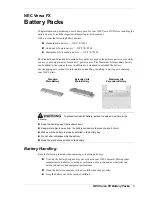
SENS EnerGenius Technical Manual
Service hotline: 1.800.742.2326
1.303.678.7500
7
4. NEUTRAL CONNECTION
The grounded circuit conductor (neutral) should be connected to the terminal marked “N” on the input
terminal block, TB1.
5. WIRE RATINGS
A. All conductors should be rated for use at 90º C or higher.
B. All input and output conductor sizes should be coordinated with the fault protection devices: 10A on AC
input (14 AWG, 2.5 mm
2
typical), 30A on DC output (10 AWG, 6.0 mm
2
typical). 1 A on Alarm terminal
block (20 AWG, 0.5 mm
2
typical).
C.
Before installation
, ensure adequate battery to charger wire gauge. Wire gauge that is too small may
activate the open battery detector and the charger will shut down. The maximum allowed resistance seen
by the charger is found in TABLE 1. These figures already include an allowance for charger variations
(they are 80% of the typical trip-point) and are for the complete circuit: total of battery leads, battery's
internal resistance, and any external equipment. The total resistance seen by the charger must not exceed
the following values:
TABLE 1
12V 24V
Maximum Resistance
58m
Ω
116m
Ω
D. To determine the appropriate cable and length, please refer to the following table:
The above lengths consider the resistance of the battery and cables only and do not take into account any
additional interconnects.
The above lengths are for operation at 25C. For high temperature installations (40C) reduce lengths by 10%.
In the case of high resistance in the cables to the battery the charger may cycle between AC Fail and
Battery Fault LEDs (approximately every 10 seconds). Cable runs exceeding the proper length for the
cable gauge used most often cause this problem. The appropriate solution is to change the cable gauge
to properly correspond with the necessary cable length (see TABLE 2). In some cases where the resis-
tance is not too far above maximum, the charger may recover after some time (approximately 10 min-
utes) and start charging the batteries. If it is not possible to decrease the system resistance the Battery
Fault feature can be disabled. Please contact SENS at 1-800-742-2326 for further information.
E.
Refer to local electrical codes for additional requirements.
F.
See Section 10 for Terminal Block wire ranges.
TABLE 2
Wire Size
Resistance
per Foot
Maximum Charger to
Battery Distance (Ft.)
AWG mm
2
m
Ω
/Ft.
12V
24V
12V
24V
10
6.0
1.00
25
50
10
19
8
10
0.63
40
79
15
30
6
16
0.40
63
126
24
48
Recommended Charger to
Battery Distance (Ft.)
6. FUSE RATINGS
A. CAUTION: For continued protection against risk of fire, replace only with same type and rating of fuse.
B. DC Output Fuse – SENS part number 304530. Bussman Type BK/ATC-30, or Littelfuse 257030
[ATO30], 30A, 32V, fast acting, blade type automotive
C. AC Input Fuse – SENS part number 304473. Bussman Type BK/AGC-10, 10A, 250VAC, fast acting,
ferrule type cylindrical, ¼” X 1-¼”




































